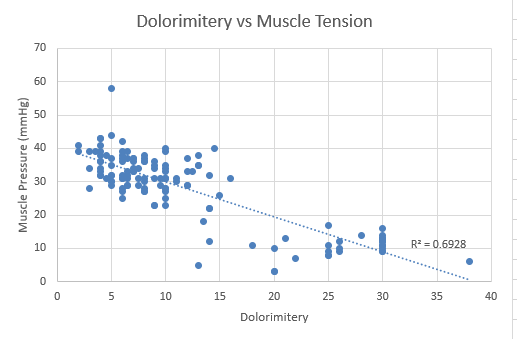Session Information
Session Type: Poster Session (Sunday)
Session Time: 9:00AM-11:00AM
Background/Purpose: Muscle pressure is elevated in fibromyalgia patients compared to controls. We have demonstrated this finding in previous studies. We wanted to determine whether a noninvasive measure such as dolorimetry correlates with muscle pressure and would be a surrogate measure for muscle tension and tightness.
Methods: Patients meeting the 2010 ACR criteria for the diagnosis of fibromyalgia syndrome (FMS) signed a consent form if they were willing to have muscle pressure obtained. The pressure was determined using a manometer inserted into the left trapezius muscle by trained rheumatologists and rheumatology nurse clinicians. Dolorimetry was used to assess the amount of muscle tenderness resulting in moderate pain. A 60-pound dolorimetry gauge was used to apply pressure to the trapezius muscle, and the patient indicated when pain intensity became moderately intense.
Results: For this analysis, all subjects (N=133) – regardless of diagnoses – were combined together in order to assess the correlation between the muscle pressure and pain scale scores. Subjects had a median age of 51 years (range 20 – 75 years), 81% were female. 77% had a diagnosis of fibromyalgia. FMS patients had a median age of 52 years (range 20 to 75 years); 85.3% were female and 14.7 % male. In the non-FMS group the median age was 47 years (range 24 to 68 years); and 64.5% were females and 35.5 % males. 102 patients had fibromyalgia and their mean (SD) dolorimetry score was 8.0 (4.36). The mean (SD) dolorimetry score in the non-FMS subjects was 25.2 (5.42). The mean (SD) total population dolorimetry score and muscle tension were 12.0 (12.0) and 27.8 (27.85), respectively. The calculated Pearson correlation coefficient for muscle tension vs pain scale for 133 subjects was -0.8323 (R-squared 0.6928; p-value < 0.0001). This indicates a highly significant association between muscle tension and subject’s dolorimetry scores.
Conclusion: Dolorimetry correlates with muscle pressure in patients with fibromyalgia. Dolorimetry indicates the amount of muscle tenderness present. It could be used as a surrogate measure for muscle pressure in patients with fibromyalgia
To cite this abstract in AMA style:
Katz Small A, Small B, Polyak Wokurka J, Katz R. Muscle Pressure as Measured by a Manometer Correlates with Dolorimetry in Patients with Fibromyalgia [abstract]. Arthritis Rheumatol. 2019; 71 (suppl 10). https://acrabstracts.org/abstract/muscle-pressure-as-measured-by-a-manometer-correlates-with-dolorimetry-in-patients-with-fibromyalgia/. Accessed .« Back to 2019 ACR/ARP Annual Meeting
ACR Meeting Abstracts - https://acrabstracts.org/abstract/muscle-pressure-as-measured-by-a-manometer-correlates-with-dolorimetry-in-patients-with-fibromyalgia/

